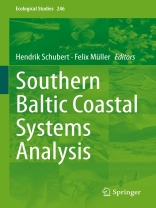This book gives an overall analysis of the current knowledge status about structures, functions, utilization for German Baltic coast ecosystems. The main focus of this book is on the aquatic area, but land/sea interactions as well as river outfalls are included as well.
Characteristic for this book is the inclusion of social science aspects. Approximately one third of its extent will be about the ecosystem services. In this segment the results of the last 6 years are presented in which a comprehensive quantification of the social relevance of ecosystems was carried out covering the entire area of the German Baltic Sea. This part builds directly on the results of scientific investigations and are in relation to social ideals. The assessment will not only be economically and ethically but also the mechanisms that are used for the valorisation of the ecosystem services will be evaluated.
Both sub-areas, the classic natural science part as well as the part of social science aspects, deal with the changes caused by increasing anthropogenic influence and social (including demographic) changes. This will be among others in the sense of an exemplary historical outline.
The final chapter of the synthesis therefore not only presents a summary of the level of knowledge gained and a deduction of the research needs. It further contains a presentation of the application aspects resulting from the analysis of the social relevance gained from basic scientific research.
The book is aimed at scientists (and students) of natural, life and social sciences, analysing functioning and structures of coastal ecosystems with regard to sustainable use and nature protection, including aspects of coastal protection. Besides, it is thought to become a reference for all levels of decision makers and stakeholders in coastal and marine management of the Baltic and North Sea region, providing also a blueprint for system analysis respecting for societal as well as biological aspects world-wide.
Tabla de materias
Part I. Introduction.- Chapter 1. Southern Baltic Coastal Systems Analysis: Questions, Conceptions and Red Threads.- Chapter 2. Coastal Ecosystems from a Social-Ecological Perspective.-
Part II.
Ecological Structures and Functions of the German Baltic Sea Coast.- Chapter 3. The Abiotic Background: Climatic, Hydrological and Geological Conditions of the Southern Baltic.- Chapter 4. Geological and Sedimentary Conditions.- Chapter 5. Environmental Conditions at the Coast: The Terrestrial Ecosystems.- Chapter 6. Environmental Conditions at the Coast: Shoreline Ecosystems.- Chapter 7. Ecosystem and Landscape Functions of the Coast: Recent Research Results.- Chapter 8: Benthic Habitats and Their Inhabitants.-
Part III. Ecological Structures and Functions of Coastal Water and Offshore Ecosystems.- Chapter 9. Introducing the Ecological Aspects
.- Chapter 10. Baltic Sea Aquatic Ecosystems in a Gradient from Land to Open Sea.- Chapter 11. Comparison of Abiotic Parameters and Dominant Primary Producers Between the Two Main Investigation Areas
.- Chapter 12. Short-Term Variability, Long-Term Trends and Seasonal Aspects in the Darß-Zingst Bodden Chain.- Chapter 13. Carbon Fluxes/Food-Webs: Effect of Macrophytes on Food Web Characteristics in Coastal Lagoons.- Chapter 14. Ecological Structure in Benthic Habitats of Offshore Waters.- Chapter 15. Patterns of Bioturbation and Associated Matter Fluxes.- Chapter 16. Seasonal Aspects and Short-Term Variability of the Pelagic Offshore Ecosystems.- Chapter 17. Long-Term Trends of the Offshore Ecosystems.- Chapter 18. Nutrient and Limitation Regimes in Coastal Water Ecosystems.-
Part IV.
Combining the Aspects: Ecosystem Service Assessment.- Chapter 19. The Human Factor: Coastal Social-Ecological Systems.- Chapter 20. Introduction: The Concept of Ecosystem Service Assessment Applied to Coastal Systems.- Chapter 21. The Missing Links in Ecosystem Service Research.- Chapter 22. Eudaimonic Valuation of Cultural Ecosystem Services.- Chapter 23. Economic Valuation of Cultural Ecosystem Services.- Chapter 24. Spatial Ecosystem Service Assessment Across the Land-Sea-Interface.- Chapter 25. Temporal Changes in Aquatic Ecosystem Services Provision: Approach and Examples.- Chapter 26. Assessing Temporal Changes in Ecosystem Service Provisions: Conceiving Future Pathways.-
Part V. Synthesis: Assessment as a Tool for Managing Coastal Ecosystems?.- Chapter 27. Applying the Integrated Approach.- Chapter 28. Mechanisms of Ecosystem Service Production: An Outcome of Ecosystem Functions and Ecological Integrity in Coastal Lagoons.- Chapter 29. Ecosystem Service Assessment in European Coastal and Marine Policies.- Chapter 30. Ecosystem Services and Sustainable Development: The Case for Strong Sustainability.- Chapter 31. Concluding Remarks.
Sobre el autor
Hendrik Schubert is Professor in Aquatic Ecology at the University of Rostock, Germany. His research interest is brackish water ecology with focus on the ecophysiology of autotrophs. Since 1998 he is also working on the biogeography of aquatic macrophytes, exploiting their potential for bioindication of the ecological status of aquatic ecosystems. He has taught aquatic ecology at the Universities of Greifswald and Rostock for about 30 years.
Felix Müller has studied Biology and Geography at the Universities of Kiel and Regensburg. His Ph D thesis about soil-geographical investigations on the fate of pesticides and nutrients in ecosystems was published in 1987. Since that time he worked at the Ecology Centre of the University of Kiel. Between 2010 and 2020 FM was affiliated as leader of the Department Ecosystem Management at the Institute for natural Resource Conservation of Kiel University, working on ecosystem theories, models and ecosystem services. In 2020 he was retired. FM has been editor of more than 20 books and special issues and has published more than 250 scientific papers. He was editor-in chief of the journal “Ecological Indicators” and board member of a number of journals.












